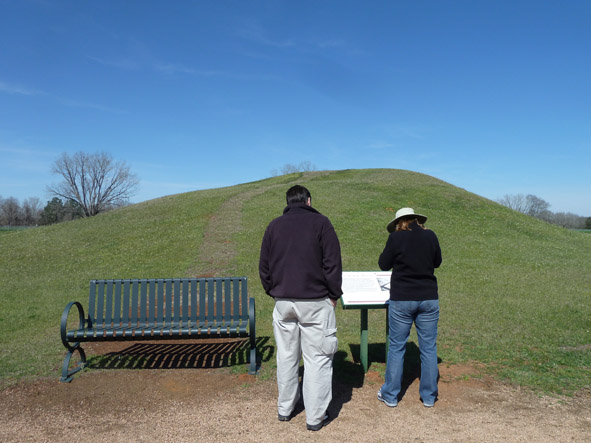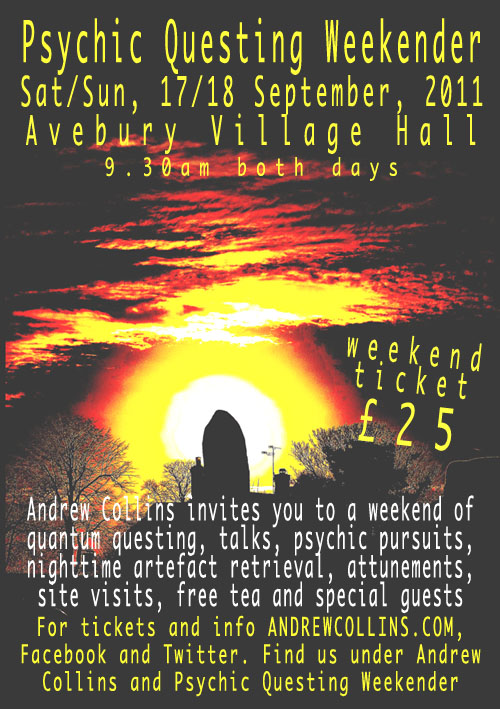![]()
![]()
Stunning
EVP (Electronic Voice Phenomena)
Caught at Ancient American Mound Site in Texas
Greg
and Lora Little at the Caddoan Mounds State Historical Park
near Alto in East
Texas where Andrew Collins captured the EVP on March 6th, 2011.
This
is the compelling story of how I caught a stunning EVP at
a native American mounds site in East Texas in March 2011
in response to a question posed,
and how it became one of a series of strange synchronicities and discoveries associated
with the Caddo-speaking mound builders who once occupied this region. More significantly,
the EVP is in the Caddoan language, spoken by those who occupied the site and
created the mounds in the first place.
On Sunday, March 6th, 2011, Andrew accompanied Greg and Lora Little to the Caddoan Mounds State Historical Park near Alto in East Texas, constructed by the Caddo-speaking Hasinai mound builders sometime between 800 and 1300 AD. I have the habit of attempting to gain responses from any possible spirit presences at a site by asking them to speak to me via a voice recorder, which is today my Blackberry cell phone (a 9520 Curve). Having had some good results in the past, I have confidence enough to know that I might be given a response to questions posed out aloud.
So on reaching the first of the mounds, which was formerly the burial place of no less than 90 or so individuals, I decided that this was a good spot to begin the communication.
For me, digital experiments like this can be combined with processes of the mind, like meditation and attunement, to attempt contact with perceived intelligences of the unseen world. Even though the native Americans might not understand the concept of EVP, a connection is still possible that, through processes unknown, can be registered as an electronic recording.
So as Greg and Lora waited quietly I posed a number of questions, such as: are there any spirits still here? Can they see us here now? Anyone present here that was buried in this mound? Has anyone a message for us? What was their name?
Knowing how important it is to be able to identify background ambient sounds on a recording, I made sure that I identified any noise I heard that might end up on the resulting sound file. Having done this, the three of us continued on the trail and passed another large mound, this one having been found to contain the remains of a round house apparently burnt to the ground, almost certainly deliberately following the death of its owner.
It was here that I called out again, this time for any spirits to give us a sign of their presence. It was at this moment that, out of the corner of my eye, I saw on the track ahead a silhouetted birdman, a shaman adorned in a cloak of feathers. Looking closely, however, I saw that this strange form was in fact, simply, a mundane metal structure on the edge of the path, but at the same time, as I drew my eyes upwards, I espied a turkey vulture hovering overhead, making sense of my apparent day dream of the imaginary birdman.
Was this the sign I had asked for - a bird shaman associated in some manner with the turkey vulture? Believing that it was, I now assumed that some unseen spirit presence was trying to tell me that bird shamanism had been important to the native American peoples that occupied the site. Even though this is a subject dear to my heart, since it features in my book The Cygnus Mystery (2006), I really hadn't been thinking about it before that moment.
We then walked on and at a viewing point that overlooks the High Temple Mound on the opposite side of the highway, I conducted a brief meditation as Greg and Lora walked on ahead. I imagined that I saw standing in front of me the aforementioned birdman. He or she was wearing a face mask, white in colour, with a short beak and dark saucer-like eyes. I tried to identity what type of bird this mask and its wearer might represent.
 | Left, the mask being worn by the birdman I saw in meditation looked very much this, although the eyes were more circular and darker. Moreover, the face in general was white and quite dirty. Right, a real Caddo mask worn during ceremonies. |  |
In all honesty, I was unsure, and on my return to the site's ticket office, which contains a small museum and cinema area, I asked the girl behind the counter whether the local tribe particularly venerated any birds as totems. She was immediate in her answer. The Caddo had revered the turkey, and conducted a ceremony called the Turkey Dance, which was important to their culture and used to express tribal history and "carry messages from the past (C. E. Carter, Caddo Indians: Where We Come From, 1995, 41)". The girl even pointed out a figure, a shaman seemingly, adorned in a coat of turkey feathers that featured in an artist's representation of a Caddo gathering. It hung out of sight on the wall behind her.
 | A Caddo ceremony, although not in this case the Turkey Dance |
That night back at the hotel in Houston I began the process of listening to the resulting sound files recorded at the mound site that afternoon. The very first one, recorded by the mound where the remains of up to 90 individuals had been found, produced a strange anomaly indeed. Two minutes into the recording I ask: "Can you see that turkey vulture in the sky? Anybody see that? What did it mean to you?" There is a brief pause before three distinct syllables are spoken slowly and deliberately by what appears to be a male voice. I interpreted them as nah-chu-ca, which clearly appeared to be representative of some language other than English. I wondered whether they belonged to the Caddo language, so checked out variations: nah-chu, nah-chou, nah-chu-co, etc, hoping to strike lucky. I found that both "nah" and "chou" were both present in Caddo grammar, but could not find anything specific.
Click on the YouTube video to listen to the EVP recorded at the Caddoan Mounds State Historical Park near Alto in East Texas on March 6th, 2011. Alternatively go to: http://www.youtube.com/watch?v=8gbX97Vs2Co
So I widened the search, and started to investigate the Caddo beliefs and traditions, wondering whether the message was in some way connected with the turkey vulture, or the turkey dance. It was then that I hit on something that absolutely stunned me. Although I could not find nah-chu-ca, I did find bah-chu'-cah, which was mentioned more than once in the following Caddo narrative:
At her bah-chu'-cah, she had left information with her daughters to tell who she was when her bah-ooh began to turn cold in her veins as she began her journey to kee-wut' ha-e'-may … Bah-chu'-cah freed her from the bondage into which she was born. (From "A tribute to George Butler")
Checking the notes beneath the account it said that bah-chu'-cah meant "death" in the Caddaon language! This seemed a perfect response to a question about what the turkey vulture might represent to the Caddo-speaking peoples. The word bah-chu'-cah was so similar to nah-chu-ca that I wondered whether I had misheard what was being said on the sound file, so I checked again and can indeed hear the voice saying bah-chu'-cah!
Clearly, "death" would be the most obvious answer to a question about the meaning of the bird's presence in the sky. It was always going to be a constant reminder of death, especially as some tribes (although seemingly not the Caddo) disposed of their dead through the use of sky-burials. This is where scavenger birds, most obviously vultures, are allowed to pick clean the carcasses of those who have died in the community.
This is done by placing the carcasses on what are known as excarnation platforms, generally located well away from human habitation. Afterwards the denuded and often calcined bones are collected up and interred in a disarticulated state, i.e. all mixed together. Such practices heavily influenced religious ideas relating to the cult of the dead, and made birds like the vulture into psychopomps, a Greek word meaning "soul carrier", i.e. an animal or bird spirit that accompanies the souls of the dead into the next world.
That night I went on to explore the symbolism behind the turkey vulture, and found that it might well have been associated with the constellation of Cygnus, the Northern Cross, which I already knew was most probably an asterism important to the Pawnee, who formed part of the Caddoen federation of tribes. They identified the Cygnus constellation as the Turkey Foot, due to the arrangement of its stars, which resemble a bird's foot. Thus both the turkey and the turkey vulture had the same celestial counterpart, which was itself seen in the past as a destination of the soul in death.
 | The territories of the Caddoan-speaking peoples of the Southwest. The Caddoan Mounds State Historical Park is in the area marked Hasinai, close to the town of Nacagdoches, East Texas. |
Somehow everything that had happened that day had come together to form a cohesive picture - one that clearly showed how digital technology can work alongside more traditional methods of interacting with the unseen world. Indeed, on playing Greg and Lora the EVP the following morning, Lora had suggested that I look for a reason why this had happened the way it did, to which I concluded that it had surely not been any coincidence that earlier that day I had asked Lora to explain Carl Jung's concept of numinosity. This she said is a psychic or mystical experience that involves the coming together of various synchronicities.
All I know is that the EVP has allowed me a connection with the Caddo, which I believe will be long lasting. I am honoured that they might well have allowed me some form of communication with them through both digital technology and meaningful experiences, like the visionary glimpse of the birdman, and the manner everything came together to create a act of personal numinosity of a type that Jung would have been very proud of indeed.
| Frequency ranges of the three syllables making up the word bah-chu'-cah, which means "death" in the Caddoan language. The third syllable is barely visible here. |  |
Thank
you to Greg and Lora Little for their driving and hospitality, and Rodney Hale
for his analysis of the Caddo EVP.
For more on the Caddoan Mounds State
Historical Park near Alto in East Texas go to http://www.tpwd.state.tx.us/spdest/findadest/parks/caddoan_mounds/
For more on the Caddo nation, see http://www.caddonation-nsn.gov/
If this subject interests you, come to the 2011 Psychic Questing Weekender where it and many of the other subjects featured on this site will be discussed by Andrew Collins and friends
Sat
17th & Sun 18th
September 2011
QUEANTUM QUESTING + RENNES LE CHATEAU REVELATIONS + GUEST SPEAKERS + NOCTURNAL ARTEFACT RETRIEVAL + VISIT TO LOCAL SITES + FREE TEAS, COFFEES AND BISCUITS + PSYCHIC MEDITATIONS + ATTUNEMENTS + PANEL DEBATE ON PSYCHIC QUESTING + TALKS ON BOTH DAYS FROM ANDREW COLLINS, THE FOUNDER OF PSYCHIC QUESTING
Village Hall (Social Centre), High Street, Avebury, Wiltshire SN8 1RF
Opens 9.30 am each day.
Saturday finish time: 6 pm plus evening artefact retrieval
Sunday finish time: 4.30 pm
Registration:
£25 for the weekend.
Click
here for full details
Click here now for Registration
![]()
![]()

